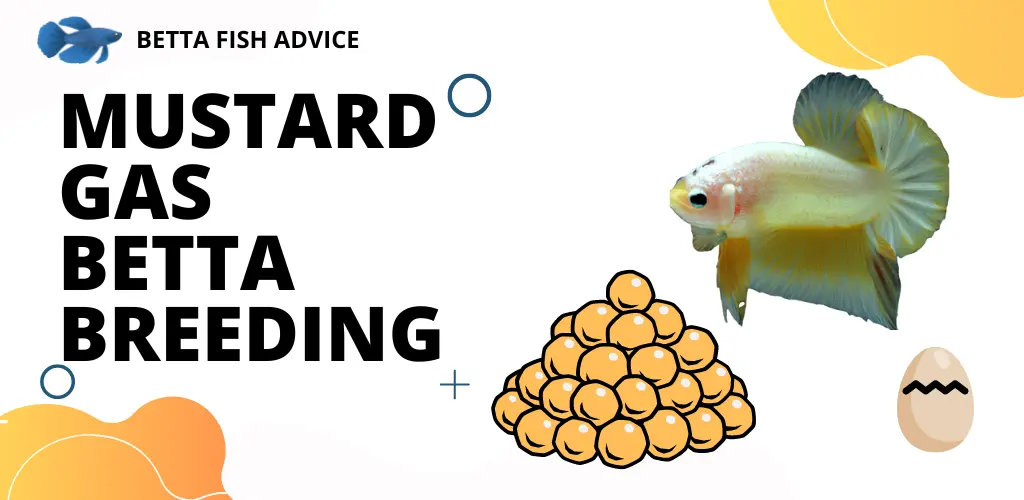Betta fish, also known as Siamese fighting fish, are a popular species of freshwater fish native to Southeast Asia. They are widely appreciated for their vibrant colors, fascinating personalities, and graceful movements. While there are wide varieties of Betta fish, the Mustard Gas Betta is a unique coloration pattern that stands out for its distinctive appearance. In this article, we will be going through What is Mustard Gas Betta and How to Care for them.
Table of Contents
What is Mustard Gas Betta?
The Mustard Gas Betta is a specific pattern of coloring that appears in Betta fish. It is characterized by its distinctive yellowish-brown body color that resembles the appearance of mustard gas. The coloration typically extends from the head to the caudal peduncle, creating a uniform appearance. In some cases, the fins may have hints of iridescence, giving the fish a metallic sheen.
What makes Mustard Gas Betta Unique?
The Mustard Gas Betta is unique because of its distinctive yellow-brown coloration, which is not commonly seen in other Betta fish varieties. The color is caused by the presence of melanin pigments in the fish’s skin and fins. The yellow-brown coloration is a recessive gene, meaning it can only be passed down from both parents to their offspring.
Physical Characteristics and Temperament of Mustard Gas Betta Fish
This Betta is a unique coloration pattern that stands out for its distinctive appearance. Regarding physical characteristics, they have a yellowish-brown body color that resembles the appearance of mustard gas, and the coloration typically extends from the head to the caudal peduncle, creating a uniform appearance. In some cases, the fins may have hints of iridescence, giving the fish a metallic sheen.
As for temperament, Mustard Gas Bettas are known for being peaceful fish that can be kept in community tanks with other peaceful fish species. However, they are also known for their territorial behavior, especially towards other male Bettas. Providing them with adequate space and hiding places is crucial to reducing stress and minimising aggressive behavior.
Mustard Gas Bettas are hardy and easy to care for, making them a popular choice for beginner aquarium enthusiasts. They require a well-maintained aquarium with clean water and appropriate temperatures. It is recommended to keep the water temperature between 76°F and 82°F and to maintain a pH of 7.0.
How to Care for Mustard Gas Betta?

Mustard Gas Bettas are hardy and easy to care for, making them a popular choice for beginner aquarium enthusiasts. They require a well-maintained aquarium with clean water and appropriate temperatures. It is recommended to keep the water temperature between 76°F and 82°F and to maintain a pH of 7.0.
In terms of food, Mustard Gas Bettas are not picky eaters and will eat a variety of food, including live, frozen, and pellets. It is essential to provide them with a balanced diet that includes a variety of protein, fiber, and other essential nutrients.
Are Mustard Gas Betta Rare?
Mustard Gas Bettas are considered a relatively rare variety of Betta fish. This is because the yellow-brown coloration is a recessive gene, meaning it can only be passed down from both parents to their offspring. Additionally, this specific coloration pattern is less commonly found in the wild or commercial Betta fish breeding operations, making it less readily available for purchase. Despite its relative rarity, the Mustard Gas Betta has gained popularity among aquarium enthusiasts and breeders for its unique and attractive appearance, contributing to its increasing availability in the pet trade. However, it is still considered a relatively uncommon variety of Betta, making it a sought-after addition for those who appreciate rare and unusual fish species.
Is Mustard Gas Dominant in Betta?
Mustard gas is not dominant in bettas, as it is a toxic chemical weapon and not a naturally occurring substance in these fish species. Bettas, also known as Siamese fighting fish, are popular pets for their vibrant colors and aggressive behavior toward other male bettas. Exposure to mustard gas would be harmful and potentially deadly to bettas and different aquatic life, and it is not a commonly found substance in their habitats. It is crucial to provide a safe and healthy environment for bettas and all pets and to avoid exposing them to harmful substances.
Mustard Gas Betta Breeding

Breeding mustard gas bettas involves selectively pairing male and female fish with the desired coloration and genetic traits, including the bright yellow-green coloration that resembles mustard gas. The process can be challenging and requires careful planning and monitoring of the fish’s health and behavior. It is vital to provide a suitable breeding environment, including a spacious tank with adequate water quality and temperature and a separate area for the female to retreat to if necessary.
During the breeding process, the male and female bettas will engage in courtship behavior, and eventually, the female will lay eggs, which the male will fertilize. After the eggs hatch, the fry must be closely monitored and provided with appropriate nutrition until they are mature enough to be separated from their parents. Breeding mustard gas bettas can be a rewarding experience for experienced hobbyists, but it also requires a significant commitment of time and resources.
Mustard Gas Betta Extinct
The mustard gas betta is not currently considered to be extinct. However, like many species of fish and other pets, bettas can face threats to their populations due to habitat loss, pollution, and over-collection for the pet trade. The bright yellow-green coloration that resembles mustard gas results from selective breeding and is not a naturally occurring coloration in the wild.
While the demand for unique and exotic coloration in bettas continues to increase, breeders and pet owners need to be responsible and support sustainable breeding practices that do not contribute to the decline of betta populations. By doing so, we can help ensure this popular pet species’ long-term survival and well-being.
Halfmoon Mustard Gas Betta
The halfmoon mustard gas betta is a unique variety of the Siamese fighting fish known for its distinctive appearance and behavior. This type of Betta is characterized by its half-moon-shaped tail fin, a result of selective breeding, and its bright yellow-green coloration, which resembles the appearance of mustard gas.
Halfmoon bettas are known for their active and playful nature and are popular among aquarium hobbyists for their distinctive appearance. It is vital to provide them with a suitable environment, including a spacious tank with adequate water quality and temperature, to maintain the health and well-being of halfmoon mustard gas bettas. While the halfmoon tail fin and mustard gas coloration are attractive features, it is important to remember that the well-being of the fish should always be the top priority when keeping bettas as pets.
Betta Fish Mustard Gas Genetic Map
A genetic map for betta fish, including mustard gas bettas, refers to the scientific study of this species’ genes and inheritance patterns. This map can help researchers and breeders better understand the genetic basis for specific traits, such as the yellow-green coloration resembling mustard gas and other physical and behavioral characteristics. The study of betta fish genetics can provide valuable information for conserving and preserving the species and developing new and improved breeding practices. A genetic map can also help identify potential health issues related to specific genes, which can be used to develop strategies for improving the health and well-being of betta fish populations.
Conclusion:
The Mustard Gas Betta is a unique and attractive coloration pattern that sets it apart from other Betta fish varieties. Its distinctive yellow-brown body color makes it a stunning addition to any aquarium. Easy to care for, this variety of Betta is a popular choice for both beginner and experienced aquarium enthusiasts.





Pingback: Betta Fish As A Pet For Kids: A Guide For Parents - Betta Fish Advice
Pingback: Bump On Betta Fish Head: Causes And Treatments - Betta Fish Advice
Pingback: Will A Betta Fish Kill A Goldfish: Can They Coexist? - Betta Fish Advice